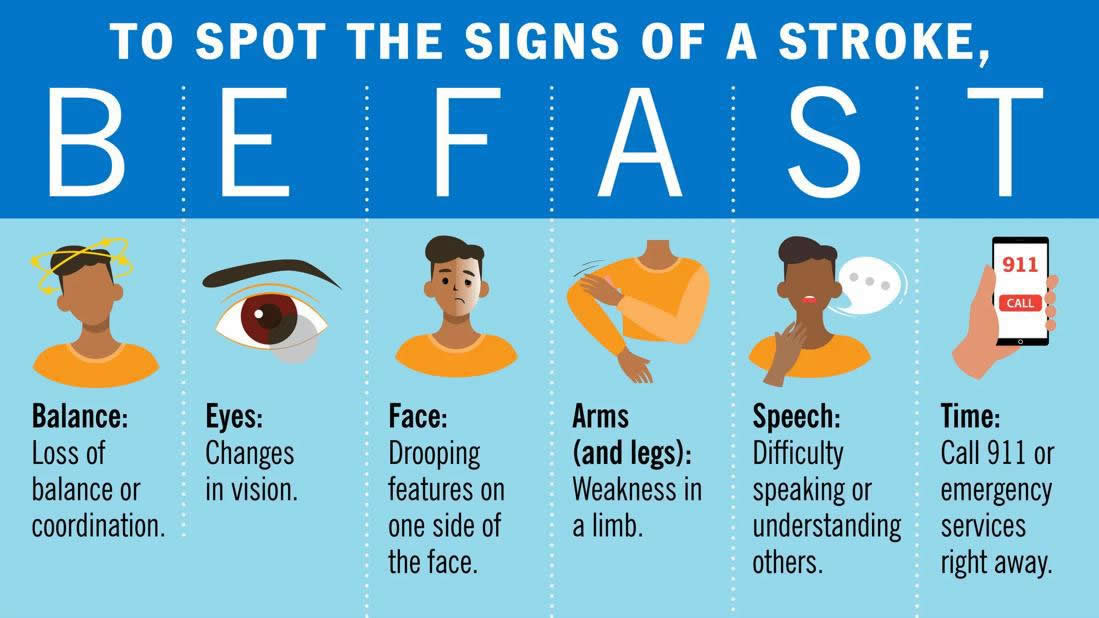Signs of a Stroke: Act Quickly With ‘BE FAST’
Seek immediate medical attention for sudden loss of balance, vision changes, slurring, facial droopiness and limb weakness

Here’s a scary fact for you: Only an estimated 36% of people in the U.S. know even one of the signs of a stroke.
“The most common signs people know about are facial droopiness and limb weakness,” says neurologist Blake Buletko, MD, “but there are other important signs to know about, too, so you can take quick action if you think you or someone else is having a stroke.”
Dr. Buletko explains the acronym BE FAST, which can help you remember the six major signs of a stroke.
BE FAST to spot the signs of a stroke
BE FAST is an acronym, meaning each letter of these two words stands for a different sign of stroke: Balance, Eyes, Face, Arms, Speech and Time.
“Remembering BE FAST can help you recognize when you or someone else is having a stroke in order to seek immediate care,” Dr. Buletko says. But what does the term BE FAST mean in practice? Let’s take a closer look:
- Bis for balance: Loss of balance or coordination.
- Eis for eyes: Changes in your vision, like losing sight in one or both eyes or starting to see double vision.
- Fis for face: Drooping facial features on one side of the face.
- Ais for arms (and legs): Weakness in one of your (or someone else’s) limbs. “If you raise your arms or legs and one of them drifts down, that’s a concern,” Dr. Buletko says.
- S is for speech: Slurring words or otherwise having difficulty speaking or understanding others.
- T is for time: Don’t take a “wait and see” approach. Call 911 or emergency services immediately.
“Remember that in the case of a stroke, you’re looking for sudden signs and symptoms,” Dr. Buletko stresses.
If these signs and symptoms occur over a longer period of time (several hours to days to weeks), they may be signs of other medical conditions (for example, Bell’s palsy can cause droopy features, and migraines can cause double vision). But when they appear suddenly and together, think stroke — and act accordingly.
Why is knowing BE FAST important?
Running through the BE FAST stroke acronym can help you determine whether you or someone else is having a stroke. Then, for the best chance of survival and recovery, it’s critical to receive care as quickly as possible.
“‘Time is brain’ — that’s what we say over and over and over again,” Dr. Buletko says. “You lose millions of neurons for every single minute your brain isn’t getting enough blood.”
During a stroke, you lose as many as 2 million brain cells per minute. This is one of the many reasons not to downplay the seriousness when it comes to the warning signs of a stroke.
“I encourage people not to dismiss these symptoms,” he states, “and I also encourage you not to think that you can get to an emergency department on your own faster than calling 911.”
Why call for help instead of trying to rush to the hospital yourself? It all comes down to the time it takes for you to get care. Paramedics are trained and equipped to assess your condition and provide on-the-go care that can save your life as they transport you to a hospital that can treat you. In some cases, they may even be able to give you anti-clotting medications and do a CT scan on the way there.
“It’s extremely important to try to deliver stroke care as quickly as possible,” Dr. Buletko reiterates, “so the best thing to do is always to call 911.”